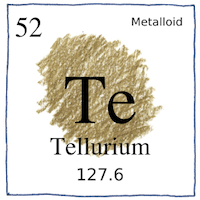Transylvania—Franz-Joseph Müller von Reichenstein,
Martin Heinrich Klaproth
elements

|
Tellurium
Franz-Joseph Müller von Reichenstein was trying to extract antimony from the gold ore known as white leafy gold ore from Faczebaja. Instead he extracted a new metalloid, unknown to science, but that fit into the periodic table next to antimony. * Martin Heinrich Klaproth isolated the same element from calaverite, another ore with tellurium and gold, gave Müller credit for the first discovery, and, in 1798, because it was “borrowed from old Mother Earth,” named it after the Latin for “earth,” tellus.
Atomic number 52
Tellurium in iron, copper, and lead alloys makes the alloys easier to machine. Cadmium telluride is sensitive to sunlight in solar panels; mercury cadmium telluride is sensitive to infrared; and zinc cadmium telluride is sensitive to X-rays. Tellurium suboxide is in the readable, writable layer in CDs, DVDs, and Blu-ray discs.
Earth miners
Ancient earth miners dug deep into mountains. Some said they were looking for gold. Some said they were trying to escape from cities and towns from the law and from mothers in law. These ancient miners sometimes found pigments, crystals, and minerals of obscure composition. Deep in the earth, their inner rooms and passageways would forget the coldness of surface stone to radiate comfort and warmth.



Pál Kitaibel independently discovered tellurium, but seven years after Müller. Klaproth did his analysis given a sample from Müller. Later metalologists, repeating similar extractions from the same minerals and ores would need to be content with finding elements that had already been found.
See also in The book of science:
Readings in wikipedia:
Other readings: